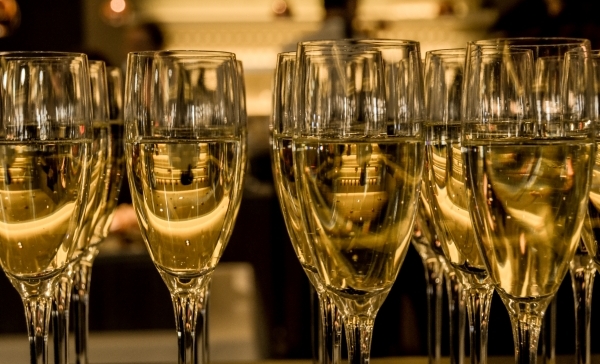
New range of pseudo-champers has a genuine sparkle

With Christmas and New Year just around the corner, we are now at least four months into champagne’s annual marketing drive, all designed to leave us in no doubt that if it doesn’t fizz, it ain’t festive. It is, indeed, the safest of assumptions that a huge number of champagne corks will be popped over the Season of Good Will. At the risk of sounding heretical, however, it seems many of us are likely to break with the orthodoxy and indulge in other forms of fizz over the festive period – and not just out of price considerations.
For generations, it has generally been assumed that champagne is the only wine that truly says celebration. Should other bubblies be substituted, this has been seen as more of a matter of penny-pinching than of preference. In most instances, that is probably still pretty much the case. Much of the attraction of Spain’s cava or Italy’s prosecco is their appeal to the pocket rather than to the palate. As a result cava, typically topped up with orange juice, is now a well-established choice, while prosecco sales have similarly boomed over recent years.

Perhaps more surprising is the surge of interest in English sparkling wines. More surprisingly still, these often cost more than the champagnes they often beat in blind tastings. The Champenois are certainly conscious of the competition. With wine consumption falling in many key markets, they seem resigned to the fact that champagne sales may never again reach the giddy heights of yesteryear.
In 2007, some 339 million bottles of champagne were shipped. In 2008, though, global sales took a major hit on account of the financial crisis. Recovery has been gradual. As of the end of 2015, sales were still only hovering around the 312.5 million mark.

Other sparkling wine categories have been notably more lively. In terms of volume, global sales of Italy’s prosecco overtook champagne in 2013, maintaining its lead ever since. Prosecco also overshadows cava although the latter is, in many ways, a more interesting drink. As the very apex of quality in the sparkling wine world, Champagne still has the territory more or less to itself. There are few contenders outside the region to compete with Dom Perignon, Krug or a number of the top cuvees from Billecart-Salmon, Bollinger or Perrier-Jouet. For more casual consumption, though, champagne has some serious competition. So what’s worth trying? While, for many, prosecco seems to be the answer, there are just as many who would demur.

Italy, however, is responsible for several sparkling wines that are far closer in style to serious champagnes – particularly in Lombardy in the Franciacorta DOCG. Franciacorta has only had its DOCG status since 1995 and, although wine has been made in the region since Roman times, it only started going into bubbles in the 1960s. U n d e r I t a l i a n w i n e l a w Franciacorta’s sparkling wines have to be made by the “traditional methods.” As a result, the region’s quality tends to be
impressively high. To date, only a limited selection is available in Hong Kong and China, although one of the best of the
producers – Bellavista – is represented by Altaya Wines.
Many lovers of sparkling wines believe that the highest quality available outside Champagne comes from one of two regions. Franciacorta is one, and the other – pretty much to everyone’s astonishment – is now southeast England. This really shouldn’t be all that surprising. The areas that are home to the most successful of the English sparkling wine producers are, after all, located close enough to Champagne to enjoy similar terroir. Unlike cava and prosecco, English sparkling wine has not had the option of competing with champagne in terms of price. Neither can it approach its production volume. Essentially, it is expensive to make, the grapes grow on small parcels of land and the vintages are unpredictable. Wine from a number of UK producers – notably Chapel Down, Gusbourne and Nyetimber – have performed consistently strongly in blind tastings in recent years. In fact, when an English sparkler beats a French fizz, it is scarcely deemed newsworthy these days.

The stand-out here is Gramona, a cava house that Berry Bros & Rudd have been promoting in Asia for some time now. As with the Franciacorta producers, Gramona uses the “traditional method.” Not all of the serious competition to the Champagne region, of course, comes from outside France. While Champagne has long been an important part of the Parisian lifestyle, when The Parisian Macao opened recently, Arnaud Echalier, its beverage operations manager, said it wouldn’t be the only sparkling wine on offer. Its wine l ist features both international sparkling wines, as well as France’s regional fizzes – Crémant de Bourgogne, Crémant de Limoux and Crémant de Loire. He says these “second tier bubbles” do not lack in quality. While Angelina is not the first sparkling wine to be made in China, it is the first to be made by the “traditional method.” It comes courtesy of the Grace Vineyard, one of the more artisanal producers and one that has garnered praise for its still wines. Its initial release in 2015 consisted of a 2009 blanc de blancs, a non-vintage blanc de blancs and two other single varietal sparkling wines – one Cabernet Franc and one Chenin Blanc. While the limited release 2009 is probably a challenge to track down now, the others in the range will certainly add a different kind – though not inferior – sparkle to your celebrations.







